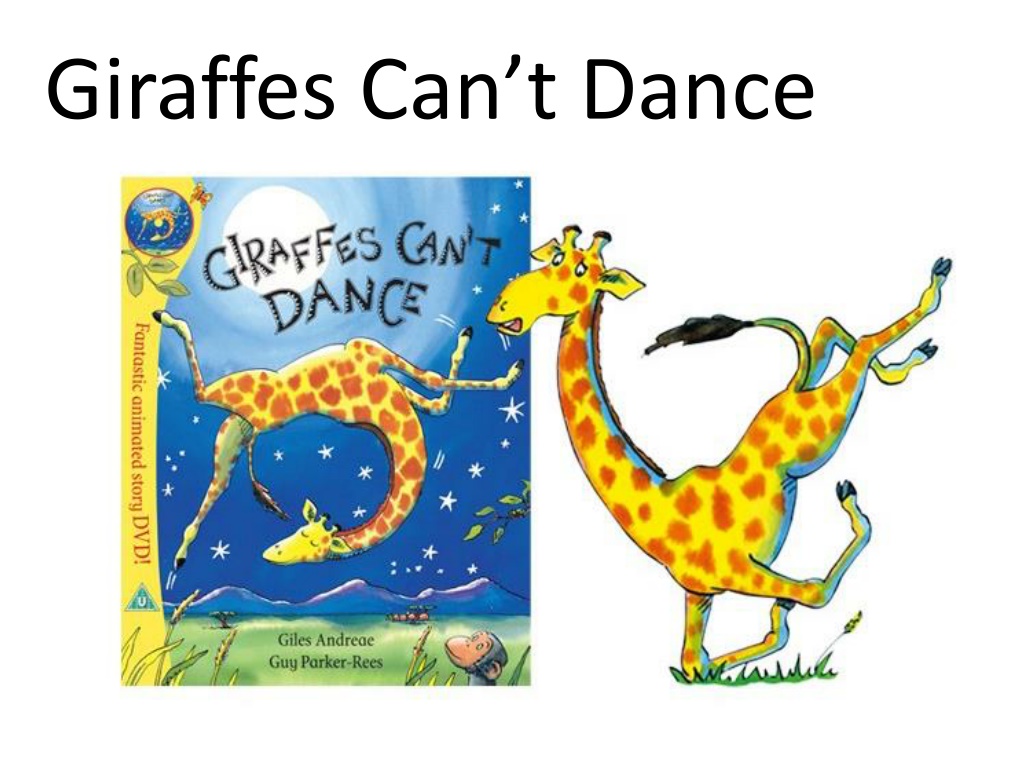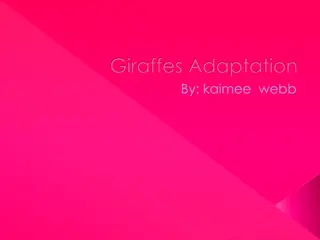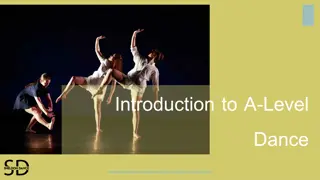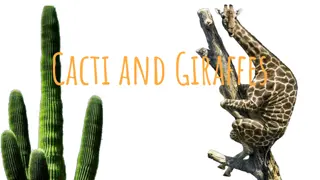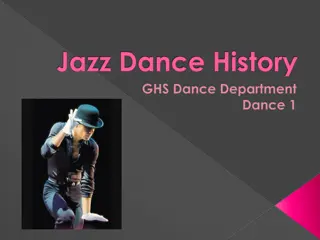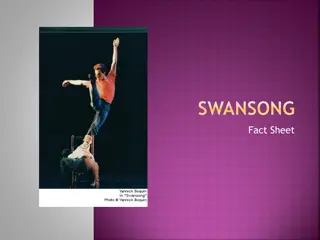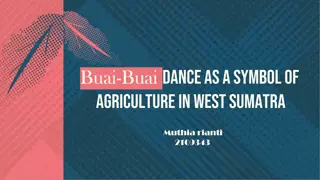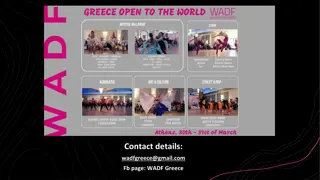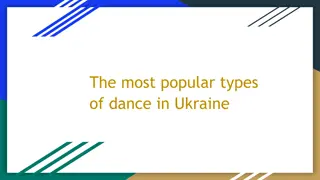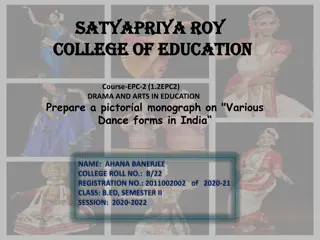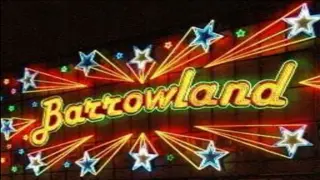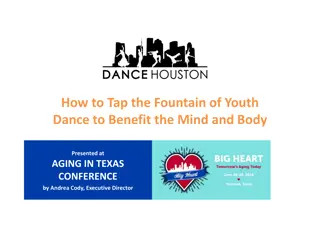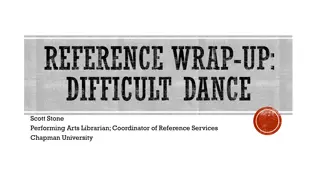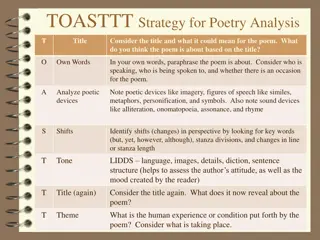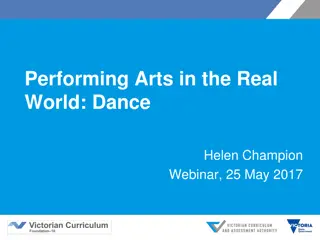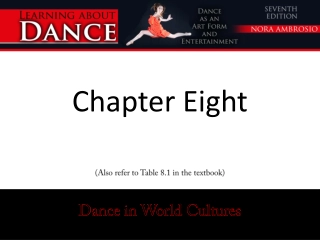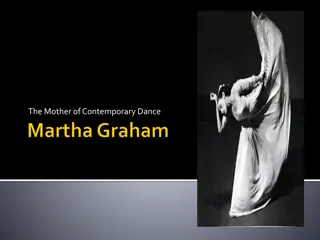Analysis of 'Giraffes Can't Dance' Story Elements
In "Giraffes Can’t Dance" story by Giles Andreae, the main character Gerald faces external and internal conflicts when other animals mock his dancing. The inciting force is the annual Jungle Dance, leading to the climax where Gerald learns to dance to his own tune with help from a cricket. This heartwarming tale teaches about self-acceptance and embracing differences through colorful illustrations and a simple storyline.
Uploaded on Sep 21, 2024 | 0 Views
Download Presentation

Please find below an Image/Link to download the presentation.
The content on the website is provided AS IS for your information and personal use only. It may not be sold, licensed, or shared on other websites without obtaining consent from the author. Download presentation by click this link. If you encounter any issues during the download, it is possible that the publisher has removed the file from their server.
E N D
Presentation Transcript
The book Giraffes Cant Dance written by Giles Andreae This is one of my favorite books personally and to read to children. I like the theme of the story, the simple text and colorful pictures.
Characters A character is a person, animal or thing that interacts with others in the story. The characters in this story were A cricket Jungle animals such as zebras, lions, monkeys, hippos, etc They are minor characters in the story and also referred to as antagonists.
Main Character This is the person/animal or thing who the story is about and generates the action of the story. The main character is also called the protagonist. The main character of this story is Gerald the giraffe.
Inciting Force The event or character that triggers the conflict. The event that triggered the conflict in this story was the annual Jungle Dance they have in the jungles of Africa.
Conflict The conflict of a story is the struggle between the antagonist(s) and protagonist. The conflict in this story was when the animals laughed and teased Gerald because he doesn t know how to dance. Hey, look at clumsy Gerald Giraffes can t dance you silly fool! Oh, Gerald you re so weird
2nd Conflict While there was the external conflict of the animals laughing at him, there was also an internal conflict. Before Gerald went to the dance, he felt insecure in himself. He did not believe in himself. He didn t think he could dance. So before he even stepped on that dance floor, he was struggling within himself. The book states, And this year when the day arrived poor Gerald felt so sad, because when it came to dancing he was really very bad.
Climax It is the high point of the story for the reader. Frequently, it is the moment of the highest interest and greatest emotion. The climax of this story is when Gerald meets cricket and cricket explains to him that everyone is different. Maybe he just needs a different song. Gerald listens to the swaying grass, the branches and the sound of the violin. Gerald starts to dance. I am dancing! Yes, I m dancing! I AM DANCING!
Falling action The falling action is the events after the climax that close the story. The falling action in this story is when the animals arrive where Gerald is dancing. They see him dancing and are amazed at how well he dances.
Resolution The resolution of a story shows how the conflict was resolved. In this story, the resolution was when the animals watch in amazement as Gerald dances like a pro. They ask him how he learned to dance. Gerald replies, We can all dance when we find the music that we love. Gerald had to find it within himself and not copy others. He had to go with the flow of the music and be himself.
Theme The main idea of the story. To me this story has two themes Believe in yourself Friendship Gerald was afraid that he could not dance because he was different. He had long lanky legs. In the story the cricket tells him But sometimes when you re different, you just need a different song. This is a great story to teach children that everyone is different and it s okay to be different. We each have things we are good at and things that we are not so good at (little kid language). We need to accept ourselves for who we are and not try to be like others.
Friendship The second theme of this story is friendship and accepting others for who they are. When Gerald went out to the dance floor the other animals laughed at him and made fun of him because he couldn t dance like they did. We need to accept people for who they are and be kind to people. We need to treat others the way we would want to be treated.
How to teach this story I would be reading this story to pre-k/Kindergarten children ages four and five. Allow children to make a prediction Before reading the story, show them the front cover and ask them what they think the story is about. What do you see on the cover? What do you think the story will be about? Why do you think that? After reading the story, I would ask questions to get them thinking about the story and the literary parts of the story. Characters Let s talk about that big word called characters. Remember the characters are the people or animals the story is about. Who did you see in this story? Who else was in the story? Who was the story about? Who was the main character?
Inciting Force and Conflict Since the children are young, you need to ask leading questions to get them to think about different parts of the story. These would be some of the questions I would ask. What was the problem in the story? How did Gerald feel in the story? How do you think he felt before going to the Jungle Dance? Do you remember? (If not, I would go back to that page and read it. The text says that And this year when the day arrived poor Gerald felt so sad, because when it came to dancing he was really very bad. How did the animals treat him? Do you think that was nice? What could they have done instead of making fun of him?
Resolution Again I would ask prodding questions to get the children to think about the resolution of the story. For me, I ask open and closed ended questions to get them to talk about the resolution. Did the problem get fixed? How did it get fixed? What happened? Who helped him? How do you think Gerald felt about himself after he learned how to dance? How did the other animals treat him? Do you think Gerald felt better about himself?
Theme Again, I would ask prodding questions to get them to think about the theme. I know it looks like I am shooting questions at them, but in reality I would wait for their answers and see if it develops into a conversation with the other children. These are some of the questions that I would plan on asking, but in real life you never know where the conversation is going to go. So what do you think this story is about? What happened in the story? Do you think the animals made good choices? How did Gerald feel about himself at the start of the book? How do you think he feels about himself now? Are we all the same? How should we treat people who are different than us?
Next Step We do a lot of Bloom s Taxonomy in our classroom so I would take the story to the next step and get to them to think about how the story could affect them. What would you do if you were at the Jungle Dance? How do you think you could have helped Gerald? Has anyone ever made fun of you? How did that make you feel? What can we do when someone makes fun of us? Again you never know where the conversation is going to go with children. Yet I would use this book as a teaching experience on how to accept ourselves for who we are and how to treat other people.
Be happy with who you are and accept yourself. We are all different and our differences make us unique. A friend is kind to their friends. We need to understand that people are different and that s okay. That s what makes them special.
